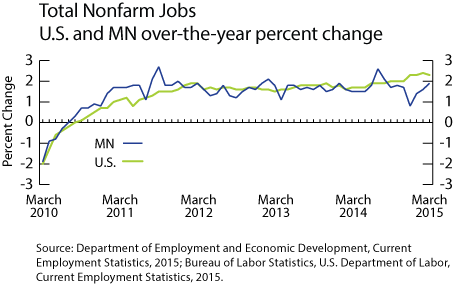by Nick Dobbins
April 2015
Monthly analysis is based on unadjusted employment data.
Employment in the Minneapolis-St. Paul MSA increased in March, adding 5,182 jobs (0.3 percent) over February estimates. The growth came largely from a handful of industry groups. Educational and Health Services added 4,272 jobs (1.4 percent) with growth in Educational Services (up 1,277 or 2.7 percent) and Health Care and Social Assistance (up 2,995, 1.1 percent). Mining, Logging, and Construction added 1,260 jobs (2.1 percent) as the weather began to warm up, Transportation, Warehousing and Utilities added 1,100 jobs (1.7 percent), and Leisure and Hospitality added 1,239 (0.7 percent). The sharpest decline came in Professional and Business Services which lost 3,222 jobs (1.1 percent) after dealing with some highly publicized layoffs in the metro area. For the year the Twin Cities metro added 39,632 jobs or 2.1 percent. The only supersector to lose employment over the year was Information, which dropped 58 jobs or 0.1 percent. Significant increases occurred in Professional and Business Services (up 8,511 or 2.9 percent), Educational and Health Services (up 10,894 or 3.6 percent), and Leisure and Hospitality (up 6,214, 3.8 percent), among others. While Mining, Logging, and Construction added just 1,013 (1.7 percent), the majority of those gains came from Specialty Trade Contractors, which added 3,229 jobs or 8.2 percent over the previous 12 months.
The Duluth-Superior MSA lost 102 jobs (0.1 percent) in March. Fluctuation was minimal at the industry level, as the only supersector to add or lose 1 percent or more of its jobs was Information, which shed a total of 15 jobs (1.0 percent) to settle at 1,420 for March. No supersector added or lost 100 jobs, with the largest numerical changes coming in Government (down 86 or 0.3 percent) and Mining, Logging, and Construction (up 54 or 0.7 percent). Employment was up annually in Duluth, with the MSA adding 401 jobs (0.3 percent) over March 2014. The growth was led by an increase in Trade, Transportation, and Utilities employment (up 847 or 3.5 percent), which in turn owed its growth primarily to the Retail Trade sector which added 678 jobs (4.6 percent). The Other Services supersector was among the others to see significant employment gains, adding 270 jobs (4.6 percent). Educational and Health Services was the biggest job shedder for the year, dropping 541 jobs (1.7 percent), and Financial Activities lost the largest proportion of its jobs, down 235 or 4.1 percent.
Rochester employment was up 305 (0.3 percent) in March, gaining back most of the 379 jobs the MSA lost in February. Supersectors with the most job growth included Mining, Logging, and Construction (up 103 or 2.9 percent), Leisure and Hospitality (up 273 or 2.8 percent) and Government, which added 118 jobs (0.9 percent) with all but 11 of those jobs coming at the Local Government level. Gains were partially offset by smaller jobs losses in a number of supersectors, including a dip of 129 jobs (0.3 percent) in Educational and Health Services. For the year Rochester added 1,056 jobs (0.9 percent). Leisure and Hospitality and Government led the way with increases of 424 (4.4 percent) and 305 (2.4 percent) respectively. Professional and Business Services (down 195 or 3.4 percent) and Manufacturing (down 140 or 1.3 percent) were the most significant job losers for the year.
The Saint Cloud MSA added a small number of jobs in March, growing by 53 or 0.1 percent on the month. Most of the movement occurred in Mining, Logging, and Construction (up 120 or 2.3 percent) and Trade, Transportation, and Utilities (down 194 or 0.9 percent) with every other supersector adding or losing less than 100 jobs and 1 percent of its total employment. Annually the MSA added 2,018 jobs (1.9 percent). Mining, Logging, and Construction (up 662 or 14 percent) and Manufacturing (up 942, 6.7 percent) were among the biggest growers, while the supersector with the most job loss was Professional and Business Services which was down 816 jobs (9.2 percent).
Employment in the Mankato-North Mankato MSA dropped by 279 jobs (0.5 percent) in March. Service Providers lost 314 jobs (0.7 percent) while Goods Producers added 35 (0.4 percent). For the year the MSA added 1,061 jobs (1.9 percent). That gain came entirely from the private sector, as Government employment was functionally flat, losing two jobs (0.0 percent).
The Fargo-Moorhead MSA added 186 jobs (0.1 percent) in March. As was the case in many MSAs, Mining, Logging, and Construction led the supersectors in growth, adding 157 jobs (2.1 percent). The biggest job loser was Manufacturing which dropped 153 jobs (1.5 percent). For the year the MSA added 4,797 jobs (3.6 percent). Manufacturing was also the only supersector to lose jobs on an annual basis, down 96 (1 percent) from March of 2014.
The Grand Forks-East Grand Forks MSA dropped 249 jobs (0.4 percent) in March. The supersectors that saw the biggest employment drops were Trade, Transportation, and Utilities (down 112 or 0.9 percent) and Mining, Logging, and Construction (down 93, 3.4 percent). On the year, Grand Forks added 1,188 jobs (2.1 percent), all in the private sector. Trade, Transportation, and Utilities led the way, up 793 (6.4 percent), with most of that growth coming from the Retail Trade sector (up 668, 8.1 percent).
